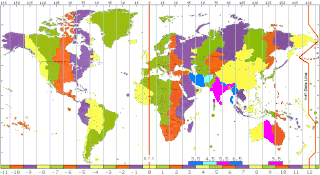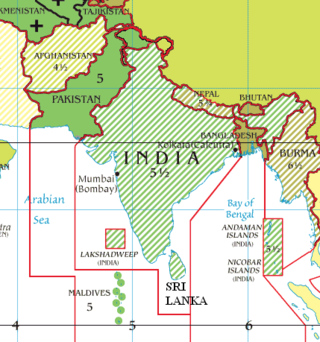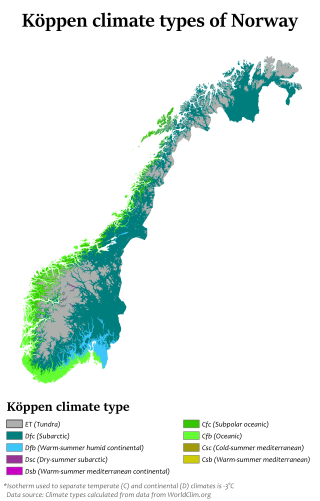
A time zone is an area which observes a uniform standard time for legal, commercial and social purposes. Time zones tend to follow the boundaries between countries and their subdivisions instead of strictly following longitude, because it is convenient for areas in frequent communication to keep the same time.

The International Meridian Conference was a conference held in October 1884 in Washington, D.C., in the United States, to determine a prime meridian for international use. The conference was held at the request of U.S. President Chester A. Arthur. The subject to discuss was the choice of "a meridian to be employed as a common zero of longitude and standard of time reckoning throughout the world". It resulted in the recommendation of the Greenwich Meridian as the international standard for zero degrees longitude.

Japan Standard Time, or Japan Central Standard Time, is the standard time zone in Japan, 9 hours ahead of UTC (UTC+09:00). Japan does not observe daylight saving time, though its introduction has been debated on several occasions. During World War II, the time zone was often referred to as Tokyo Standard Time.

Svalbard and Jan Mayen is a statistical designation defined by ISO 3166-1 for a collective grouping of two remote jurisdictions of Norway: Svalbard and Jan Mayen. While the two are combined for the purposes of the International Organization for Standardization (ISO) category, they are not administratively related. This has further resulted in the country code top-level domain .sj being issued for Svalbard and Jan Mayen, and ISO 3166-2:SJ. The United Nations Statistics Division also uses this code, but has named it the Svalbard and Jan Mayen Islands.

The historic prime meridian or Greenwich meridian is a geographical reference line that passes through the Royal Observatory, Greenwich, in London, England. The modern IERS Reference Meridian widely used today is based on the Greenwich meridian, but differs slightly from it. This prime meridian was first established by Sir George Airy in 1851, and by 1884, over two-thirds of all ships and tonnage used it as the reference meridian on their charts and maps. In October of that year, at the behest of US President Chester A. Arthur, 41 delegates from 25 nations met in Washington, D.C., United States, for the International Meridian Conference. This conference selected the meridian passing through Greenwich as the world standard prime meridian due to its popularity. However, France abstained from the vote, and French maps continued to use the Paris meridian for several decades. In the 18th century, London lexicographer Malachy Postlethwayt published his African maps showing the "Meridian of London" intersecting the Equator a few degrees west of the later meridian and Accra, Ghana.

Indian Standard Time (IST), sometimes also called India Standard Time, is the time zone observed throughout the Republic of India, with a time offset of UTC+05:30. India does not observe daylight saving time or other seasonal adjustments. In military and aviation time, IST is designated E* ("Echo-Star"). It is indicated as Asia/Kolkata in the IANA time zone database.

Central European Time (CET) is a standard time of Central, and parts of Western Europe, which is one hour ahead of Coordinated Universal Time (UTC). The time offset from UTC can be written as UTC+01:00. It is used in most parts of Europe and in a few North African countries. CET is also known as Middle European Time and by colloquial names such as Amsterdam Time, Berlin Time, Brussels Time, Budapest Time,Madrid Time, Paris Time, Rome Time,Prague time,Warsaw Time or Romance Standard Time (RST).
.sj is the Internet country code top-level domain (ccTLD) reserved for the designation Svalbard and Jan Mayen. The domain name registry is Norid, but .sj is not open for registration. The issuing of the domain was based on the ISO 3166 designation of Svalbard and Jan Mayen, which consists of two separately administrated integrated territories of Norway: the Arctic archipelago Svalbard and the nearly uninhabited volcanic island Jan Mayen. .sj was designated on 21 August 1997, at the same time as Bouvet Island was allocated .bv. Both were placed under the .no registry Norid, which is also the sponsor. Norwegian policy states that .no is sufficient for those institutions connected to both Svalbard and Jan Mayen, and therefore the domain is not open to registration. It is Norwegian policy not to commercialize domain resources, so there are no plans to sell .sj. Should the domain later come into use, it will be under regulation of the Norwegian Communications Authority and follow the same policy as .no. There are two second-level domains reserved for the two areas: svalbard.no and jan-mayen.no, but other web addresses are also used.
Malaysian Standard Time or Malaysian Time (MYT) is the standard time used in Malaysia. It is 8 hours ahead of Coordinated Universal Time (UTC). Malaysia does not observe daylight saving time.
The UTC offset is the difference in hours and minutes between Coordinated Universal Time (UTC) and local solar time, at a particular place. This difference is expressed with respect to UTC and is generally shown in the format ±[hh]:[mm], ±[hh][mm], or ±[hh]. So if the time being described is two hours ahead of UTC, the UTC offset would be "+02:00", "+0200", or simply "+02".

Iran Standard Time (IRST) or Iran Time (IT) is the time zone used in Iran. Iran uses a UTC offset UTC+03:30. IRST is defined by the 52.5 degrees east meridian, the same meridian which defines the Iranian calendar and is the official meridian of Iran.

India uses only one time zone across the whole nation and all its territories, called Indian Standard Time (IST), which equates to UTC+05:30, i.e. five and a half hours ahead of Coordinated Universal Time (UTC). India does not currently observe daylight saving time.

The climate of Norway is more temperate than could be expected for such high latitudes. This is mainly due to the North Atlantic Current with its extension, the Norwegian Current, raising the air temperature; the prevailing southwesterlies bringing mild air onshore; and the general southwest–northeast orientation of the coast, which allows the westerlies to penetrate into the Arctic. The January average in Brønnøysund is 15.8C (28.6F) higher than the January average in Nome, Alaska, even though both towns are situated on the west coast of the continents at 65°N. In July the difference is reduced to 3.2C (5.8F). The January average of Yakutsk, in Siberia but slightly further south, is 42.3C (76.1F) lower than in Brønnøysund.
Switzerland uses Central European Time (CET) during the winter as standard time, which is one hour ahead of Coordinated Universal Time (UTC+01:00), and Central European Summer Time (CEST) during the summer as daylight saving time, which is two hours ahead of Coordinated Universal Time (UTC+02:00).

Denmark, including its dependencies of Faroe Islands and Greenland, uses six time zones.
Time in the Kingdom of the Netherlands is denoted by Central European Time during the winter as standard time in the Netherlands, which is one hour ahead of coordinated universal time (UTC+01:00), and Central European Summer Time (CEST) during the summer as daylight saving time, which is two hours ahead of coordinated universal time (UTC+02:00). The Caribbean Netherlands – which consist of the islands of Bonaire, Sint Eustatius and Saba – all observe Atlantic Standard Time (AST) year-round, which is four hours behind coordinated universal time (UTC−04:00).

Finland uses Eastern European Time (EET) during the winter as standard time and Eastern European Summer Time (EEST) during the summer as daylight saving time. EET is two hours ahead of coordinated universal time (UTC+02:00) and EEST is three hours ahead of coordinated universal time (UTC+03:00). Finland adopted EET on 30 April 1921, and has observed daylight saving time in its current alignment since 1981 by advancing the clock forward one hour at 03:00 EET on the last Sunday in March and back at 04:00 EET on the last Sunday in October, doing so an hour earlier for the first two years.

Svalbard, an archipelago in the Arctic Ocean belonging to the Kingdom of Norway, uses Central European Time (CET) during the winter as standard time, which is one hour ahead of Coordinated Universal Time (UTC+01:00), and Central European Summer Time (CEST) during the summer as daylight saving time, which is two hours ahead of Coordinated Universal Time (UTC+02:00). This is shared with the rest of Norway, as is Svalbard's use of daylight saving time, which the territory observes annually by advancing the clock forward on the last Sunday in March and back again on the last Sunday in October. However, as Svalbard experiences midnight sun during the summer due to being located north of the Arctic Circle, it gives daylight saving time no utility, and is only observed in order to make communicating with Norway Proper more convenient. At the 74th parallel north, the midnight sun lasts 99 days and polar night 84 days, while the respective figures at the 81st parallel north are 141 and 128 days.

Time in Liberia is given by a single time zone, denoted as Greenwich Mean Time. Liberia shares this time zone with several other countries, including fourteen in western Africa where it was formerly known as Western Sahara Standard Time (WSST). Liberia has never observed daylight saving time (DST).
Time in Sudan is given by a single time zone, officially denoted as Central Africa Time. Sudan has observed CAT since 1 November 2017. Sudan has not observed daylight saving time since 14 October 1985.













